Your Cart is Empty

Occupational therapists are skilled at turning fun arts and crafts projects into skill-building opportunities. They naturally assess all of the language, motor, and cognitive processes needed by combining their professional task analysis skills with a whole lot of fun!
What OTs know is that skills are developed through meaningful occupation, and for children, that occupation is play.
When children are engaged in play, they are learning and developing critical fine motor, visual motor, and sensory motor skills that are often the focus of "therapy."
Parents at home can promote their child's development by creating opportunities for play. Regardless of where your child is along their developmental journey, we've come up with a few therapy-inspired activities that are simple enough for parents and kids alike!
Children with autism demonstrate a range of cognitive, motor and language abilities, sensory preferences, and interests or aversions. When you are considering how best to engage your child with autism in play-based activities, always keep their individual needs and interests in mind.
Occupational therapists will often "scaffold" activities to help children build their skills for learning rather than become frustrated by difficult tasks. We often refer to this as a "just-right challenge."
This resource from Kids Matter explains how parents can offer similar supports at home by trying the following:
For children who are interested in sensory-based play or whose level of engagement and participation improves when there is a sensory component to the activity, these fun sensory art ideas will be a huge hit at home!
For children who dislike getting messy or avoid painting because of tactile defensiveness, try encouraging creativity by using household objects and toys in new ways - baking trays, straws, sponges, marbles, spice shakers, q-tips - change up your painting tools for a different experience every time! Here are our favorite out-of-the-box ways to create with paint: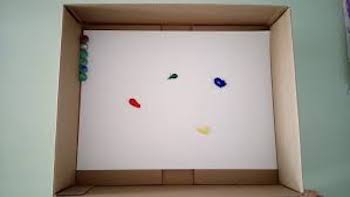
Marble Run Painting: Put blank paper into the lid of a box or baking tray, add a glob of your paint color (choose 1 at a time or add a few!) and a marble or two. Tilt the box/tray to move the marble through the paint and watch the kaleidoscope of colors emerge across the paper.
Q-Tip Details: Using a Q-tip to apply paint in controlled dots, lines, or squiggles is a great way to develop fine motor skills while also limiting the "mess." Depending on the level of creativity or independent drawing skills your child has, consider adding a background picture and use the Q-tip paint to add details to familiar shapes, landscapes, or people.
Paint in a Bag: Similarly to the sensory bag, children with significant tactile defensiveness are more apt to engage with this painting activity because the mess is all contained inside a Ziploc-type bag. Put a blank piece of paper inside of the bag, add a few drops of color, and zip the bag closed. By pushing on the outside of the bag, your child can move the paint around and explore with mixing colors to decorate a kaleidoscope on the canvas.
Stamping: Look around the house and see what you could use as a stamp - cut an apple or potato in half to stamp a unique shape, repurpose those Duplo Legos, or cut a kitchen sponge into shapes big and small.
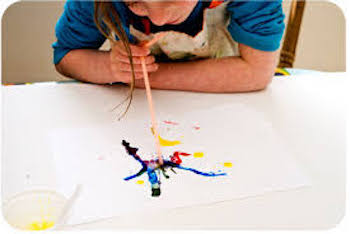
Blow-Paint: They actually sell blow paints for kids, but they require a lot of forceful breath that may be difficult for some kids to coordinate. Create your own "blow" paint activity by breathing through a straw to move the paint across the page. Can you blow the paint inside the shape of a balloon? To add colorful details to a picture already drawn? or to make your own free-form designs?
Beyond Paint
Your final product will surely look different, and you might have to wash away your art at the end of the activity, but the kids will get a kick out of creating with something other than paint. Who says that art has to happen on paper? Explore your washable surfaces in the bathtub, sliding door or window, and even go outside with an old easel. Art is easy when you can wash away the mess!
When I plan a craft project for a child with any developmental needs, I'm always careful to plan something engaging that the child will be able to successfully complete.
Remember that the process is more important than the final product! How you get the project done will differ based on the amount of prompting, physical support, and language support needed by the child. It's important to add a "challenge" and that challenge will always change based on the child completing the project.
For example, in a craft project that requires kids to peel and stick shapes to decorate a silly face, the challenge could be the fine motor skill of "peeling." For another child, the challenge may be tolerating the "sticky" sensation. For a third child, it may be following the directions to "put on" or the visual-spatial skills to organize shapes into a face-like design.
Or, perhaps all of these skills are difficult. This is when it's important to know your child's strengths and weaknesses, plan how you will best support them, and make a conscious effort to enable as much independence as possible while also fostering fun and success.
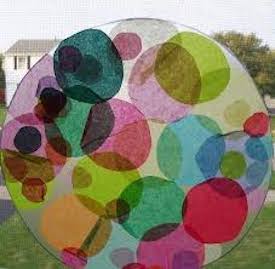
Paper Plate Crafts - Who knew that a simple white paper plate could offer so much for crafting creativity! Turn your plates into animals, flowers, rainbows, or these adorable caterpillars. Work on coloring, cutting, and gluing skills to make something as simple or multi-step as your child needs it to be.
Contact Paper Shapes - practice ripping, cutting, picking up tissue paper, matching shapes, and tolerating sticky contact paper to create a stained glass-like design. Change the theme to reflect seasonal colors and shape.
Storytelling - Why not reinforce simple stories or routines by creating crafts related to what your child is learning? We love crafts that will help your child to retell, reenact, or reinforce the characters or activities in a story.
Mobiles - Take lacing and threading to a new 3-D level by creating a mobile of highly visually engaging materials. Beads, straws, and strings of all colors and textures attached to a coat hanger, hula hoop, or curtain rod can be fun projects to add to over time and display in your child's sensory area.
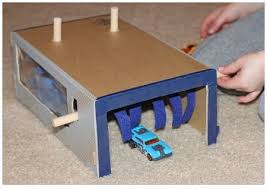
It's Not a Box! - It's way more! Turn your large cardboard box into a firetruck, police car, drive-in movie theater, camper, or anything else your imagination desires. Recruit your child to help with painting the outside of the box, drawing windows, or adding pretend-play details that will prompt ideas for play. Think smaller and turn the box into a car garage, mailbox, or television to incorporate with other play materials.
Feeling crafty? Check out this linkfor even more ideas and bring them to life with the help of your child.
A successful art project for kids with autism will appeal to their various sensory interests. An activity that provides tactile, visual, auditory feedback will promote engagement! Try these ideas for sensory-informed art projects that meet a sensory need.
Sensory Bags- Work with your child to fill a gallon-sized freezer bag with your choice of baby shampoo, shaving cream, glitter, small objects, and/or food coloring of your choice. You'll want to secure the bag closed with some duct tape to make sure the contents don't spill onto your child's lap (or your furniture!). Here are 3 ways we would encourage play with the sensory bags long after your creation is completed!
Glue and... Sensory art isn't limited to glitter and paint! Think of how to include everyday textures into sensory play - sand, shaving cream, foam, cardboard, and rice glued to different surfaces can create a sensory collage. Take a nature walk and gather leaves, sticks, pine cones, rocks, and dirt (yes dirt!). Add a bit of glue to create a landscape, person, diorama, or mobile. Here are 10 ideas for creating with nature from Fantastic Fun and Learning that are sure to inspire some sensory craft ideas.
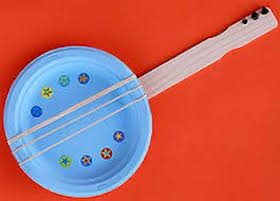
Making Music:Why not turn some of those everyday sensory materials into something musical? Hard pasta, rice, beads, tin foil, and rubber bands all provide different auditory feedback when you shake or roll it inside a cardboard tube. Music is a great way to engage children with language and motor imitation, so consider turning your next craft time into a music maker.
This article from How Wee Learn gives parents 42 ideas for DIY musical instruments for kids.
Sensory Bottles- Sensory bottles can serve different purposes: calm-down sensory bottles help with self-regulation, visual stimulation sensory bottles can meet a self-stimulation need, and eye-spy sensory bottles can offer a fun activity. Whatever you choose to put in your sensory bottle, these are fun crafts to create with your child and incorporate language and fine motor skills. For more information on sensory bottles, check out this article.
Arts and crafts are excellent ways to engage children in learning through play. Plan activities that will foster your child's participation in meaningful and supported ways and remember that the process is more important than the end product. Start small, you and your child will both feel more successful when you master the basic project and build skills from there.
Incorporate your child's sensory interests into the arts and crafts projects and involve your child however possible when you're creating the sensory materials they will play with!
Do you have ideas for teenagers,, especially boys
Outstanding art activities! I will try them all with my four year old.
Comments will be approved before showing up.


Karen Carty
August 27, 2025
I’m an elementary art teacher. This school year we have a group of Kinder through 2nd grade students with autism. Thank you for some ideas!